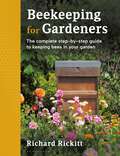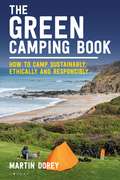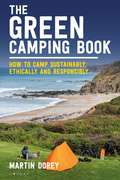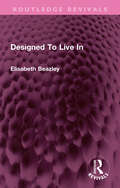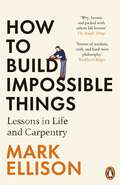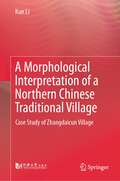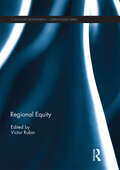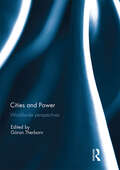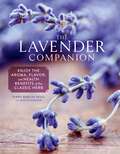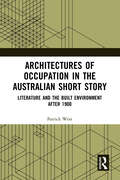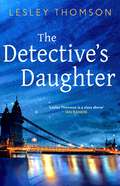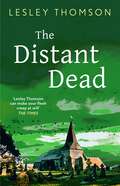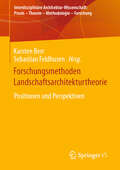- Table View
- List View
Beekeeping for Gardeners: The complete step-by-step guide to keeping bees in your garden
by Richard RickittA comprehensive gardener's guide to sustainable beekeeping.Beekeeping has changed. While once it was a hobby that pursued the rich rewards of honey and wax, many new beekeepers now instead seek the gratification of knowing that they are aiding the survival of one of the world's most important creatures. Keeping bees today is as much about providing the right habitats and resources to help pollinators thrive as it is about chasing every drop of golden honey.This beautifully illustrated guide to the ancient hobby of beekeeping shows today's gardeners how to create beautiful gardens that are richly rewarding for people and bees alike. Flowers, shrubs, trees and vegetable plots can provide colourful beauty and delicious produce as well as vital pollen and nectar when bees need it the most. There are lists of the top-performing plants and how and where to grow them, including window boxes, lawns, borders, wild gardens and even ponds.Beekeeping for Gardeners looks at the pleasures and benefits of keeping honey bees in gardens of all types and sizes, both rural and urban. It explains the practicalities involved in keeping bees in the domestic garden setting, as well as on rooftops, allotments, parks, farmland and other locations. Importantly, and unlike any book before, this guide sets the delightful hobby of beekeeping within the context of the wider environment, asking how it can best serve the needs of all types of pollinator and the local ecology in general.Whether you're looking to attract more bumblebees and solitary bees or want to install a beehive, this wonderful book contains all the guidance you'll need to have a garden buzzing with bees.
The Green Camping Book: How to camp sustainably, ethically and responsibly
by Mr Martin DoreyFrom Martin Dorey - lifelong camper, campervanner and committed environmentalist - a manifesto on how to camp greener and more responsibly while enjoying the outdoors.Planet earth is in crisis. Climate change is affecting everyone, and everyone has a responsibility to do all they can to make things better, including campers and campervanners. In fact, it often falls to us to protect our spaces and fight to keep them the way we like them.This book shows us how we can do it. The Green Camping Book signposts you towards making more sustainable choices about kit, where to stay, how to travel, what to wear, and what we can keep doing to fight for green spaces we love. It is a book for people who want to reduce their impact and carbon footprint but don't want to stop exploring. It is for people who want to get out, off the sofa, and into the wilderness without doing it further damage. It is for people who think they could do more, but don't know how. It asks of everyone who likes spending time outdoors to think about their impact and to take urgent, important steps to soften their footprint on the world.
The Green Camping Book: How to camp sustainably, ethically and responsibly
by Mr Martin DoreyFrom Martin Dorey - lifelong camper, campervanner and committed environmentalist - a manifesto on how to camp greener and more responsibly while enjoying the outdoors.Planet earth is in crisis. Climate change is affecting everyone, and everyone has a responsibility to do all they can to make things better, including campers and campervanners. In fact, it often falls to us to protect our spaces and fight to keep them the way we like them.This book shows us how we can do it. The Green Camping Book signposts you towards making more sustainable choices about kit, where to stay, how to travel, what to wear, and what we can keep doing to fight for green spaces we love. It is a book for people who want to reduce their impact and carbon footprint but don't want to stop exploring. It is for people who want to get out, off the sofa, and into the wilderness without doing it further damage. It is for people who think they could do more, but don't know how. It asks of everyone who likes spending time outdoors to think about their impact and to take urgent, important steps to soften their footprint on the world.
Designed To Live In (Routledge Revivals)
by Elisabeth BeazleyOriginally published in 1962, this book traces the main influences behind modern design in domestic architecture. It does so against the context of the effect each new dwelling has on its environment and the effect its design has on those in the surrounding (and often older, historic) housing stock. Diverse influences such as the bye-law street and Le Corbusier’s Ville Radieuse are discussed, while the ideas bearing on the individual private house range from those of the early nineteenth century villa builders to Frank Lloyd Wright’s prairie houses and the work of Mies van der Rohe. The book closes with a detailed discussion of the problems and possibilities of domestic design in house-building in the late 20th Century
Designed To Live In (Routledge Revivals)
by Elisabeth BeazleyOriginally published in 1962, this book traces the main influences behind modern design in domestic architecture. It does so against the context of the effect each new dwelling has on its environment and the effect its design has on those in the surrounding (and often older, historic) housing stock. Diverse influences such as the bye-law street and Le Corbusier’s Ville Radieuse are discussed, while the ideas bearing on the individual private house range from those of the early nineteenth century villa builders to Frank Lloyd Wright’s prairie houses and the work of Mies van der Rohe. The book closes with a detailed discussion of the problems and possibilities of domestic design in house-building in the late 20th Century
How to Build Impossible Things: Lessons in Life and Carpentry
by Mark EllisonA RADIO 4 BOOK OF THE WEEK'Sturdy advice, delivered with humour and the occasional splinter' Guardian‘Gorgeous . . . contains fascinating insights about working with your hands, the nature of talent, and how to create a meaningful life’ A. J. Jacobs, bestselling author of The Puzzler‘Exquisite, purposeful, absorbing . . . a book with much to teach us all’ Ayad Akhtar, Pulitzer Prize–winning author of Homeland Elegies‘People think I’m a genius because I remember my high school math’When Mark Ellison left high school, no one thought he would go anywhere. A self-proclaimed ‘serial dropout’, Mark spent his young adult years taking work where he found it. Who would have thought that forty years later he would be regarded as a great carpenter, making a living out of building homes for the rich and famous?Full of warmth, wisdom and irreverent humour, this is the story of what carpentry can teach us about the satisfaction and joy that comes from doing something well for a long time. From staircases that would be deadly if built as designed to algae-eating snails boiled to escargot in a penthouse pond, Mark exposes the messy wiring behind the pristine walls - and the mindset that any of us can develop to build our own impossible things. Written with refreshing candour, this is an essential book about building life on your own terms, and the possibilities that await when we forge our own path.
A Morphological Interpretation of a Northern Chinese Traditional Village: Case Study of Zhangdaicun Village
by Kun LiThis book challenges the definition of a new approach for integrating protection and enhancing the Chinese heritage category of “Traditional Villages”. By applying a specific case study in the Hancheng context, Shaanxi Province, which lacks sound studies, the book formulates new theoretical prerequisites for future re-searches, an in-depth knowledge path, and sound methodological principles. By working in a multiple scales approach, the object of preservation and enhancement is first of all redefined in its ontology as a unity formed by the courtyard type, the morphology of the village, and the related landscape structures. All these three levels of study have been deeply investigated, put into the relationship and resulting in a new methodology which overcomes the inadequacy and ineffectiveness of the notion of “setting” deriving from conservation Charters, to embrace the structural notion of “context” and a knowledge approach to rural settlements’ form. The innovative and original features of this book are both in the reading villages in their landscape dimension, which in turn is studied as a context made of several interrelated structures. Another original feature of the book is the integration of Italian historic-structural and morphological methodologies with specific Chinese cultural aspects. The author’s work dug deeply and interdisciplinary in all those dimensions to account for the complex issues that are related and embodied in both the physical and intangible meaning of human settlements, opening a novel scientific methodology for Chinese studies as a sound base to define three key integrated project actions: what, why, how to preserve, enhance, develop.
Regional Equity (Community Development – Current Issues Series)
by Victor RubinRegional equity as a field of scholarship, as an arena of policy change, and as a social movement has grown, diversified, and matured in important ways over the past decade. The fruits of that growth and development can be seen in recent federal and state policies, in the practices of many regional planning organizations, and in the agendas and approaches of countless community-based organizations and issue advocacy groups.As the field has expanded, a growing number of researchers have been tracking these phenomena: explaining how and why concepts of metropolitan development are being reframed; documenting the efforts to shape policies and diversify leadership; assessing where and how equity and social justice concerns have been brought into regional planning for transportation, land use, housing, public finances, environmental quality, smart growth, sustainable development, public health and other issue areas. This volume brings together analyses and commentary by some of the leading scholarly observers these timely developments.This book was published as a special issue of Community Development.
Cities and Power: Worldwide Perspectives
by Göran TherbornWhat do cities tell us about power? How does power shape cities? These are the main questions answered by a multidisciplinary set of eminent urban scholar in crisp articles on capital cities from around the world, from Buenos Aires to Tokyo, from Jakarta to Moscow. Focus is on contemporary cities and their manifestations and representations of power, though often with a historical grounding, and the collection also includes an example of archaeological urban analysis, from northern Mesopotamia. Through its variety of approaches by leading scholars of the field, and its variety of cities with their different histories and their diverse national contexts and political organization the book gives a uniquely insightful and easily accessible world overview of cities of power.This book was published as a special issue of the International Journal of Urban Sciences.
The Lavender Companion: Enjoy the Aroma, Flavor, and Health Benefits of This Classic Herb
by Jessica Dunham Terry Barlin VesciA celebration of lavender featuring stunning photographs; favorite recipes for the kitchen, pantry, and body care products; along with fascinating lore and gardening guidance from a destination lavender farm. Lavender has long been a favorite herb with its amazing, resinous fragrance; calming qualities; and unique flavor for seasoning food. This lavishly photographed celebration of the beloved herb, written by an acclaimed lavender farmer and cooking instructor, is brimming over with inspiration and ideas for bringing the fragrance and flavor of lavender into daily life. The book profiles the most popular lavender varieties and their recommended uses, along with the history, lore, and traditional medicinal uses. More than 40 recipes showcase lavender in delicious dishes from the kitchen as well homemade craft and body products. Tips for success with lavender in the garden complete this perfect gift for every lavender lover.
Architectures of Occupation in the Australian Short Story: Literature and the Built Environment after 1900
by Patrick WestPatrick West’s Architectures of Occupation in the Australian Short Story cultivates the potential for literary representations of architectural space to contribute to the development of a contemporary politics of Australian post-colonialism.West argues that the predominance of tropes of place within cultural and critical expressions of Australian post-colonialism should be re-balanced through attention to spatial strategies of anti-colonial power. To elaborate the raw material of such strategies, West develops interdisciplinary close readings of keynote stories within three female-authored, pan-twentieth century, Australian short-story collections: Bush Studies by Barbara Baynton (1902); Kiss on the Lips and Other Stories by Katharine Susannah Prichard (1932); and White Turtle: A Collection of Short Stories by Merlinda Bobis (1999). The capacity of the short-story form to prompt creative and politically germinal engagements with species of space associated with architecture and buildings is underscored. Relatedly, West argues that the recent resurgence of binary thought—on local, national, and international scales—occasions an approach to the short-story collections shaped by binary relationships like a dichotomy of inside and outside. Concluding his argument, West connects the literary and architectural critiques of the story collections to the wicked problem, linked to ongoing colonial violences, of improving Australian Indigenous housing outcomes.Innovative and interdisciplinary, this book will be of interest to scholars and students of Literary, Architectural, and Postcolonial Studies. .
Architectures of Occupation in the Australian Short Story: Literature and the Built Environment after 1900
by Patrick WestPatrick West’s Architectures of Occupation in the Australian Short Story cultivates the potential for literary representations of architectural space to contribute to the development of a contemporary politics of Australian post-colonialism.West argues that the predominance of tropes of place within cultural and critical expressions of Australian post-colonialism should be re-balanced through attention to spatial strategies of anti-colonial power. To elaborate the raw material of such strategies, West develops interdisciplinary close readings of keynote stories within three female-authored, pan-twentieth century, Australian short-story collections: Bush Studies by Barbara Baynton (1902); Kiss on the Lips and Other Stories by Katharine Susannah Prichard (1932); and White Turtle: A Collection of Short Stories by Merlinda Bobis (1999). The capacity of the short-story form to prompt creative and politically germinal engagements with species of space associated with architecture and buildings is underscored. Relatedly, West argues that the recent resurgence of binary thought—on local, national, and international scales—occasions an approach to the short-story collections shaped by binary relationships like a dichotomy of inside and outside. Concluding his argument, West connects the literary and architectural critiques of the story collections to the wicked problem, linked to ongoing colonial violences, of improving Australian Indigenous housing outcomes.Innovative and interdisciplinary, this book will be of interest to scholars and students of Literary, Architectural, and Postcolonial Studies. .
The Detective's Daughter: A gripping Sunday Times crime club thriller to lose yourself in (The Detective's Daughter #1)
by Lesley ThomsonAs winter closes its grip on snow-bound London, a cleaner determines to solve the case that her detective father never could. A Kindle number one bestseller. It was the murder that shocked the nation. Kate Rokesmith, a young mother, walked to the banks of the Thames with her three-year-old son. She never came home.For three decades, the case file has lain, unsolved, in the corner of an attic. Until the detective's daughter, Stella Darnell, starts to clear out her father's house after his death...Reviews for The Detective's Daughter: 'A haunting novel about loss and reconciliation, driven by a simple but clever plot' Sunday Times 'This book has a clever mystery plot – but its excellence is in the characters, all credible and memorable, and in its setting in a real West London street, exactly described' Literary Review 'A thoughtful, well-observed story... It reminded me of Kate Atkinson' Scott Pack 'A cerebral thriller... Evokes chills from more than just the frigid winter nights' Forward Reviews Magazine 'Lesley Thomson gets better and better' Ian Rankin
The Distant Dead: (The Detective's Daughter Book 8) (The Detective's Daughter #8)
by Lesley ThomsonA woman lies dead in a bombed-out house. A tragic casualty of the Blitz? Or something more sinister? Sixty years later, the detective's daughter unearths the truth... From the number 1 bestselling author of The Detective's Daughter.LONDON, 1940Several neighbours heard the scream of the woman in the bombed-out house. One told the detective she thought the lady had seen a mouse. Another said it wasn't his business what went on behind closed doors. None of them imagined that a trusting young woman was being strangled by her lover.TEWKESBURY, 2020Beneath the vast stone arches of Tewkesbury Abbey, a man lies bleeding, close to death. He is the creator of a true-crime podcast which now will never air. He was investigating the murder of a 1940s police pathologist – had he come closer to the truth than he realised?Stella Darnell has moved to Tewkesbury to escape from death, not to court it. But when this man dies in her arms, Stella, impelled to root out evil when she finds it, becomes determined to hunt down his killer and to bring the secrets he was searching for into the light...Praise for The Detective's Daughter series:'Lesley Thomson gets better and better' Ian Rankin'Cunningly plotted' Mick Herron'One of the most original characters in British crime fiction... Thomson's plots are original and she draws her characters with genuine affection' Sunday Times'In the best traditions of the classic whodunnit, this is Midsomer Murders for grown-ups' Jake Kerridge, Sunday Express'Gloriously well-written... Thomson creates a rich and sinister world that is utterly unique' William Shaw
Forschungsmethoden Landschaftsarchitekturtheorie: Positionen und Perspektiven (Interdisziplinäre Architektur-Wissenschaft: Praxis – Theorie – Methodologie – Forschung)
by Karsten Berr Sebastian FeldhusenWie werden in Forschungsarbeiten in der Landschaftsarchitekturtheorie Erkenntnisse gewonnen? Um diese Frage zu beantworten, ist es sinnvoll, die Methode der Forschung einer individuellen Forschungsarbeit anschaulich zu machen. Ziel des Buchs ist es, eine Übersicht an aktuellen Forschungsmethoden im Feld der Landschaftsarchitekturtheorie zu geben. Damit möchte das Buch einen Beitrag zur Methodendiskussion in der Landschaftsarchitekturtheorie leisten, die häufig gefordert, aber selten geführt wird. Die Aufsätze in dem Buch sind untereinander formal und inhaltlich abgestimmt: Formal haben sie einen ähnlichen Aufbau, sodass die Methoden gut miteinander verglichen werden können. Inhaltlich sind die Aufsätze insofern miteinander abgestimmt, weil jeder Aufsatz für eine bestimmte Forschungsmethode in der Landschaftsarchitekturtheorie steht.
